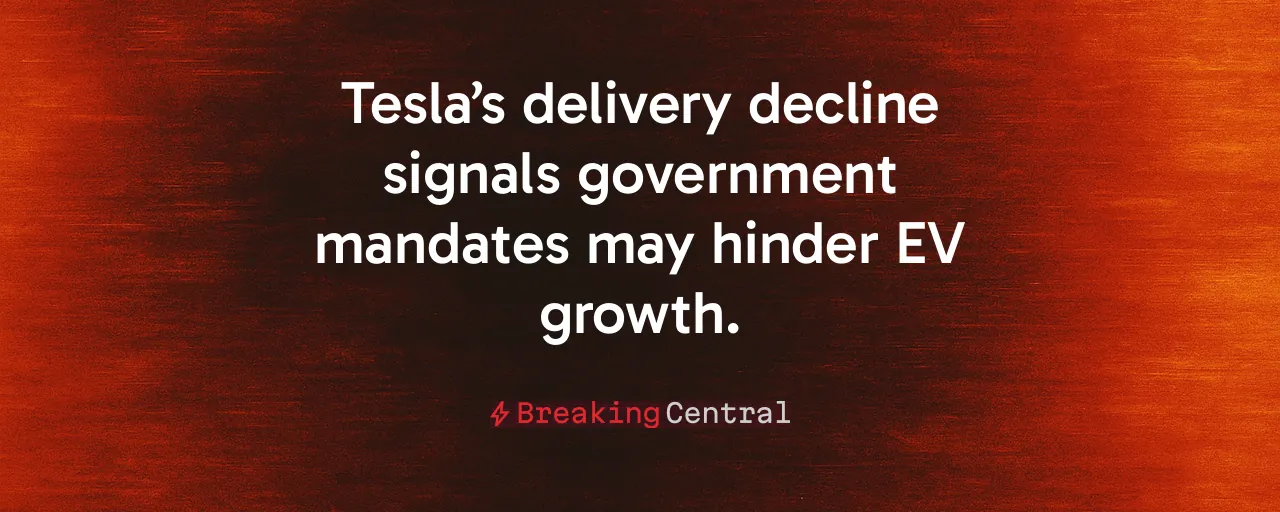A Wake-Up Call From Tesla's Numbers
Tesla's latest report came as a stark reminder. The company produced 410,244 vehicles in Q2 2025 but delivered only 384,122, missing analyst expectations of around 389,000. This marks Tesla's second straight year-over-year quarterly delivery decline, down 13% from Q2 2024. While the numbers show sequential improvement from a rough Q1, they raise a deeper question: Is the government's heavy-handed push for electric vehicles backfiring?
The shortfall is a symptom of a broader issue, one that extends beyond Tesla. Policymakers have bet big on EVs, using subsidies and mandates to force adoption. Despite its dominance, Tesla's struggle suggests consumers aren't fully on board. The gap between production and deliveries, about 26,000 vehicles, points to inventory piling up. This indicates a warning, rather than a demand surge.
Mandates Misfire, Markets Deliver
Government intervention often distorts markets, and EVs are no exception. Federal tax credits and state-level mandates have propped up Tesla for years, helping it capture roughly 40% of the U.S. EV market. As credits shrink under the current administration, Tesla's delivery declines expose the fragility of artificial demand. Consumers, not bureaucrats, are the ones to decide what cars they drive.
Tesla's success, ironically, proves the power of private enterprise. Its vertical integration, with 85% of content sourced in North America, shows companies can localize supply chains without government meddling. Tesla's energy storage unit posted strong profits in Q2, even as vehicle margins slipped. Innovation, rather than handouts, keeps Tesla ahead.
Regulation Strangles Progress
Overregulation threatens to choke Tesla's momentum. Autonomous driving, a cornerstone of Tesla's future, faces a tangle of federal and state rules. Delays in approving Full Self-Driving technology stifle innovation and raise costs. Streamlining approvals would let companies like Tesla test and deploy safer systems faster, benefiting drivers and the economy.
Labor policies loom large. Unionization drives at Tesla's plants could disrupt its lean operations. While workers deserve fair treatment, forced union models often lead to inefficiencies that hurt competitiveness. Tesla's ability to innovate depends on flexibility, rather than rigid labor structures imposed by external agendas.
China's Shadow and Trade Realities
Tesla's reliance on Chinese battery materials is a strategic vulnerability. With global EV sales growing 25-30% year-over-year, China's dominance in supply chains gives it leverage. Reducing trade barriers with allied nations for critical minerals would strengthen U.S. automakers and align with national security. Free trade, rather than protectionism, builds resilience.
Historical data backs this up. Tesla's delivery growth soared 50% annually from 2012 to 2022, fueled by open markets and minimal competition. As Chinese brands like BYD close the gap, Tesla's edge depends on securing stable, non-hostile supply chains. Policy should enable, not obstruct, this shift.
Lessons From Tesla's Past
Tesla's early days offer perspective. From 2012 to 2022, it thrived with modest subsidies and a clear vision. Price cuts in 2023 and 2024 maintained market share, but at the cost of margins, now hovering near 2%. The lesson? Companies adapt best when markets, rather than mandates, set the pace. Tesla's pivot to energy storage and robotaxis shows it can innovate without being spoon-fed incentives.
Challenges remain. Legal battles over Autopilot crashes and workplace conditions signal growing pains. These are reasons to let Tesla resolve issues through accountability and market discipline, rather than doubling down on regulation. Private solutions often outpace government fixes.
Charting a Better Course
Tesla's stumble is a chance to rethink EV policy. Scaling back mandates and subsidies would force automakers to compete on merit, driving down costs and improving quality. Consumers benefit when companies innovate to earn their dollars, not to check regulatory boxes. Tesla's ability to maintain 40% market share despite reduced credits proves this approach works.
Public-private partnerships could expand charging networks without wasteful spending. Transparent safety standards for autonomous vehicles would balance innovation with public trust. These steps prioritize freedom and accountability over bureaucratic control, aligning with values that reward hard work and ingenuity.
The road ahead for Tesla, and the EV industry, hinges on unleashing market forces. Tesla's Q2 numbers are a setback, not a defeat. By doubling down on innovation and rejecting government overreach, America can lead the auto industry's future. The question is whether policymakers will trust the market to drive.
